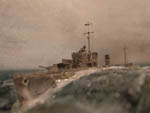 This
a scratch built/ kit bash using parts of the Airfix HMS Hotspur. The first
part of scratch building came when detailing the deck. The moulded on anchor
cables and capstans were cut off. The quarterdeck and fo'c'sle had the anti-skid
pattern engraved with a knife and then the details were added. The capstans
were made out of stretched sprue. The reinforcements under the cables and
the breakwater were made out paper. Once this basic detail had been added
I decided to begin the task of building the sea base.
This
a scratch built/ kit bash using parts of the Airfix HMS Hotspur. The first
part of scratch building came when detailing the deck. The moulded on anchor
cables and capstans were cut off. The quarterdeck and fo'c'sle had the anti-skid
pattern engraved with a knife and then the details were added. The capstans
were made out of stretched sprue. The reinforcements under the cables and
the breakwater were made out paper. Once this basic detail had been added
I decided to begin the task of building the sea base. 
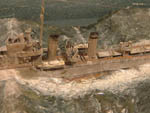 I
had been wanting to make a rough sea but couldn't find the model to suit it;
enter a small, easily built destroyer that would be right at home in a gale.
The large waves were made out of layers of card with a recess cut in the middle
for the ship. These blocks were then covered in papier maché and painted.
The painted hull, minus boot topping, was glued in place. Around five layers
of acrylic gel were used to shape these large waves and make smaller ones.
The advantage of using many layers was a that a translucent effect, generated
by 5mm of clear gel over a painted base, was obtained.
I
had been wanting to make a rough sea but couldn't find the model to suit it;
enter a small, easily built destroyer that would be right at home in a gale.
The large waves were made out of layers of card with a recess cut in the middle
for the ship. These blocks were then covered in papier maché and painted.
The painted hull, minus boot topping, was glued in place. Around five layers
of acrylic gel were used to shape these large waves and make smaller ones.
The advantage of using many layers was a that a translucent effect, generated
by 5mm of clear gel over a painted base, was obtained.
 Now
that the base was nearly finished I could build the more delicate parts of
the ship. The anchors, from the 1/720 Italeri HMS Hood, were added and White
Ensign Models (WEM) photo etch (PE) cables put in place. The bollards were
removed from the Airfix HMS Belfast and the fairleads were from WEM. The next
project was the forward and aft superstructures. The aft one just had the
cumbersome and inaccurate spray shield replaced with paper. This was done
to the forward one as well, but not before a 1.5mm layer of plasticard was
Now
that the base was nearly finished I could build the more delicate parts of
the ship. The anchors, from the 1/720 Italeri HMS Hood, were added and White
Ensign Models (WEM) photo etch (PE) cables put in place. The bollards were
removed from the Airfix HMS Belfast and the fairleads were from WEM. The next
project was the forward and aft superstructures. The aft one just had the
cumbersome and inaccurate spray shield replaced with paper. This was done
to the forward one as well, but not before a 1.5mm layer of plasticard was
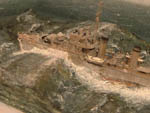 added
to increase the height of the superstructure. The bridge and its components
were taken from Hotspur
added
to increase the height of the superstructure. The bridge and its components
were taken from Hotspur 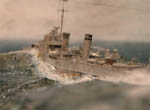 but
with substantial improvements. The flagdeck was replaced with plasticard and
a CA soaked paper screen. The screens on the bridge were made out of paper,
as were the doors on the director. The protrudings on the rear of the bridge
were built using paper and white glue was used to make the bases. The supports
above the bridge were stretched sprue.
but
with substantial improvements. The flagdeck was replaced with plasticard and
a CA soaked paper screen. The screens on the bridge were made out of paper,
as were the doors on the director. The protrudings on the rear of the bridge
were built using paper and white glue was used to make the bases. The supports
above the bridge were stretched sprue.
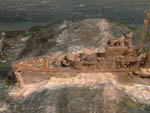 The
forward and aft superstructures were then glued onto the painted deck.
The
forward and aft superstructures were then glued onto the painted deck.  The
next job was the 4.7inch mountings. The kit shields were solid plastic, so
were replaced with paper ones. The barrels, breeches and bases were taken
from the Italeri Hood. The collection trays and counter balances at the rear
of the mountings were also constructed from paper.
The
next job was the 4.7inch mountings. The kit shields were solid plastic, so
were replaced with paper ones. The barrels, breeches and bases were taken
from the Italeri Hood. The collection trays and counter balances at the rear
of the mountings were also constructed from paper.
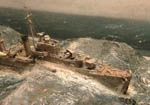 The
Airfix torpedo tubes were basic but useable. To improve them I added compressed
gas bottles (made from WEM pompom magazines) and screens made from paper.
The other weapons, the Vickers mounted amidships, were built from the WEM
PE set. Their platform was from the Hotspur kit, but had the screens replaced
with… trusty paper! The search light platform was also made using this versatile
material; the lights were from the Hood kit. The Carley floats are taken from
the Airfix Belfast.
The
Airfix torpedo tubes were basic but useable. To improve them I added compressed
gas bottles (made from WEM pompom magazines) and screens made from paper.
The other weapons, the Vickers mounted amidships, were built from the WEM
PE set. Their platform was from the Hotspur kit, but had the screens replaced
with… trusty paper! The search light platform was also made using this versatile
material; the lights were from the Hood kit. The Carley floats are taken from
the Airfix Belfast.
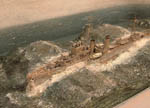
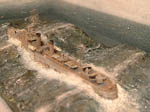 The
funnels were taken from the Hotspur kit, given a clean up and detailed. The
steam pipes are wire, the sirens on the aft funnel are the magazines from
a spare PE Vickers. The platform was from the WEM 1/700 Tribal PE set. The
cages were constructed using a basic 'X' shape made by part of the radar from
a Type 42. The other four spars were stretched sprue. WEM PE doors and ladders
were added and the scuttles drawn on with pencil. The
The
funnels were taken from the Hotspur kit, given a clean up and detailed. The
steam pipes are wire, the sirens on the aft funnel are the magazines from
a spare PE Vickers. The platform was from the WEM 1/700 Tribal PE set. The
cages were constructed using a basic 'X' shape made by part of the radar from
a Type 42. The other four spars were stretched sprue. WEM PE doors and ladders
were added and the scuttles drawn on with pencil. The life rings were painted on and plasticard lockers added into various places.
Before the boats could be added the anti-skid strips and boot- topping were
applied. This was done by painting masking tape brown and dark grey respectively
and then cutting it into strips and sticking it on. This technique was also
used to make the funnel band.
life rings were painted on and plasticard lockers added into various places.
Before the boats could be added the anti-skid strips and boot- topping were
applied. This was done by painting masking tape brown and dark grey respectively
and then cutting it into strips and sticking it on. This technique was also
used to make the funnel band.
 The
boats were from a box of spares; the davits were from the WEM 1/700 Tribal
PE set as was one of the torpedo davits (the other is paper), bullring on
the prow and depth charge rack; the depth charges and davits on the stern
were taken from the Hotspur kit.
The
boats were from a box of spares; the davits were from the WEM 1/700 Tribal
PE set as was one of the torpedo davits (the other is paper), bullring on
the prow and depth charge rack; the depth charges and davits on the stern
were taken from the Hotspur kit. 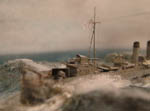
The masts were built last, so as to prevent them being knocked about during
the rest of the build. They were built out of wire of various thicknesses.
The crow's nest is sprue. WEM PE railings and GMM figures were then put in
place, a PC printed pennant number added and then the weathering process began.
 A
black/brown watercolour wash was used to bring out different areas of the
ship, such as the torpedoes, and to look like dirt and grime. A red/brown
ash was used to paint on rust. Graphite was used on the apicies of various
parts to break them up, e.g. the 4.7inch mountings. White paint was used to
highlight the waves and the streaks of water running off the hull. Cotton
wool was used to simulate water gushing out of the hawsaws
A
black/brown watercolour wash was used to bring out different areas of the
ship, such as the torpedoes, and to look like dirt and grime. A red/brown
ash was used to paint on rust. Graphite was used on the apicies of various
parts to break them up, e.g. the 4.7inch mountings. White paint was used to
highlight the waves and the streaks of water running off the hull. Cotton
wool was used to simulate water gushing out of the hawsaws  and
to simulate the water being forced out as the ship ploughed through the water.
It was also used to give the effect of the sea
and
to simulate the water being forced out as the ship ploughed through the water.
It was also used to give the effect of the sea 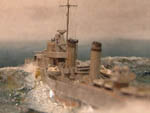 being
whipped into a spray by the wind. The ship was then sprayed with a satin varnish
so as to appear 'wet' in 1/600 scale. The fo'c'sle, iron deck, hull and sea
were sprayed with a gloss varnish.
being
whipped into a spray by the wind. The ship was then sprayed with a satin varnish
so as to appear 'wet' in 1/600 scale. The fo'c'sle, iron deck, hull and sea
were sprayed with a gloss varnish.
The final task was to add the rigging, made from stretched sprue and a White
Ensign, made from a design printed from my pc onto decal paper.
N.B Some of the colours in the photos are not the true colours, I got the
lighting wrong in some of them